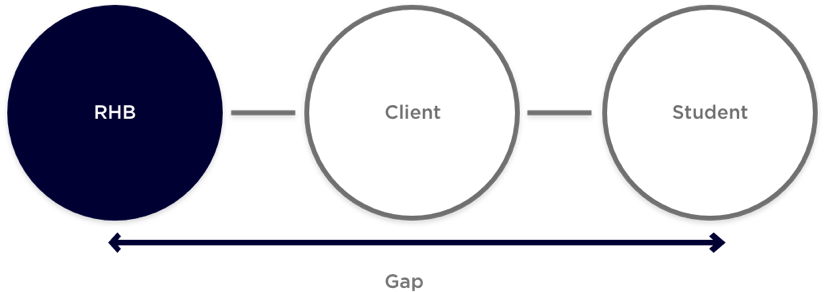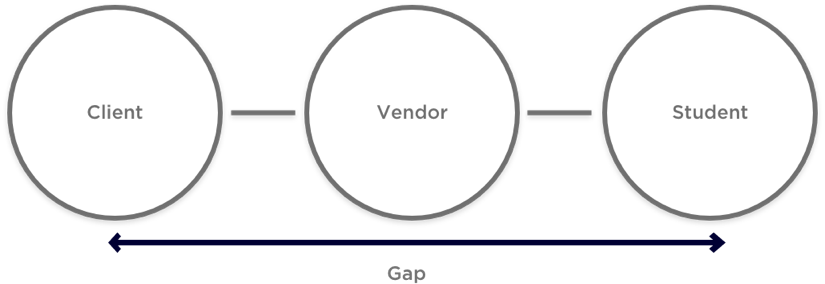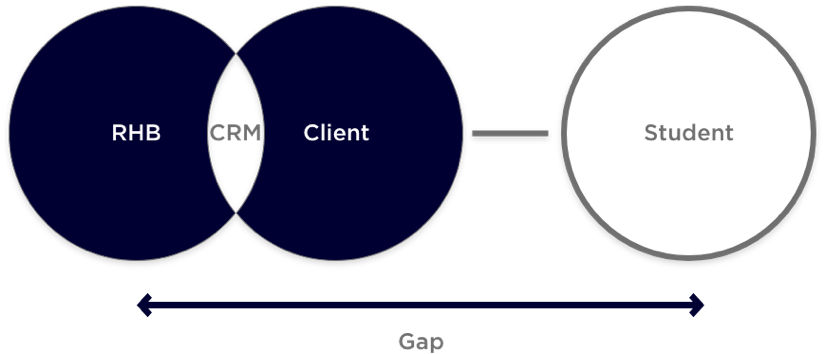Using Your CRM to Own Prospect Relationships
After 30 years of developing thousands of projects for prospective students and influencers, we’ve developed a process that allows us to meet the mindset of prospects with tactics that move them along to the next decision point. And with every microsite, segmented email campaign, campus visit table and viewbook, we get in the mud with our clients to configure a way to convey market position and institutional values to equip families to make informed decisions.
But there’s always a gap. Years ago I developed a model for our team that shows where RHB’s work ultimately ends: when the project moves from our hands to the customers’ hands…for them to deliver to their customers.

Now, some of those projects had a more direct delivery. A microsite for instance, was live and available to students (our customer’s customers), but still needed a tactic to drive people to the site. Others, like a viewbook, went to a mailing house where a prospect list was delivered and the mailing dropped. Yet, all response to those pieces didn’t route through RHB (nor should they—more on that later), it went to the client for measurement and subsequent activity. Two important things occur in the gap: direct implementation and response measurement.
Many good firms close this gap by keeping the implementation and measurement on the vendor side. An example of this is traditional (they wouldn’t describe themselves this way) student search firms. A campaign is developed, a list is purchased, search is deployed, inquiries are gathered and returned to the institution. Billion-dollar industries close the gap between implementation and measurement by keeping it all on the vendor side.
Yet, this simply creates a different gap and new resource overlap: the vendor is now an avatar of your institution and the interaction with the student has left the purview of the institution. The vendor sits between you and the student.

The work likely sits outside of your data management system and away from counselors until some criteria are met. I’ve spoken ad nauseam about this; the infrastructure that supports these outsourcing options is available on campuses at varying degrees. This illustrates the student search industry, but applies to display, SEO and social as well. There is certainly ample space for outside expertise in those industries, but there’s a critical difference between buying tools and buying expertise.
At RHB, we’ve chosen alternate paths to closing the gap between our customer and theirs, by focusing our energy in two areas. The first is the process of developing the tools. RHB employs the Coherence model, which starts with an intimate investigation of the student experience with students. We utilize two primary methods: Circles of Influence and Customer Journey Mapping, both of which provide an unparalleled view of what it’s like to attend an institution. These findings, when overlaid upon institutional priorities, allow us to develop tactics that position us creatively closer to the institution and its audiences.
Second, in our enrollment marketing work, we’ve discovered that closing the gap between RHB and the end user means identifying campus tools that we can share and optimize with the client institution. Notably, CRM solutions.

Our motivation for investing in CRM, namely Slate and Salesforce, is twofold: first, to get the intended communication vehicle to prospects without burdening the client with implementation; and second, to assure that the strategy reaches its intended goal, without indirect interference from RHB or additional software cost.
So, how do we do this? First and foundationally, RHB commits to the idea that our expertise should enhance on-campus abilities, not replace them. Our mission statement reflects this: We help great causes succeed.
Second and most pragmatically, we build a team that has expertise in enrollment marketing and CRM integration and implementation. RHB is headquartered in Indianapolis, alongside Salesforce. Our instant, expert access has allowed us to utilize the Marketing Cloud in innovative and disruptive ways.
And, any conversation about higher ed CRM needs to include Slate. With significant market penetration and user satisfaction, Slate’s impression on higher education is more than burgeoning. Indeed, part of its appeal is its purpose-built nature, allowing enrollment managers to record, analyze and implement strategies with unprecedented ease. Our Slate clients are equipped to recruit students and take previously outsourced initiatives in-house at lower-cost and with higher levels of efficiency. All of this presents a clear signal about the future of enrollment marketing and the industries that support it.

